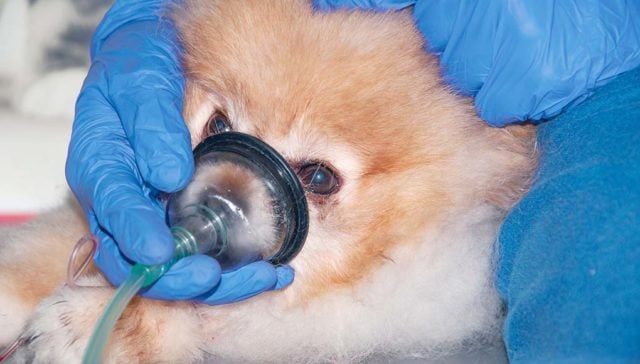
Table of Contents
Warm temperatures can trigger dog breathing problems.
But did you notice your Fidos breathing unusually all the time?
In this article, we'll cover what factors can affect your dog's normal breathing and the required treatments.
To start, there are 3 main symptoms of breathing problems in dogs that pet owners are likely to deal with:
- labored breathing
- rapid breathing
- panting
These types of breathing issues in dogs can be the result of an illness or blockage by a foreign object. (Discussed in detail below.)
In severe cases, viral respiratory diseases can also come into play.
As canine expert Jane E. Sykes states:
The longer dogs are housed in a shelter situation, the greater the risk that respiratory illness will occur.
That said, it's important to understand the symptoms, causes, and other factors of breathing problems in dogs to determine the next steps.
For reference, a healthy dog’s breathing is typically about 20-34 breaths each minute, and it should not seem like a struggle.
Dog Breathing Problems: 3 Common Symptoms
1. Labored Breathing
Also called dyspnea, labored breathing happens when dogs have to work very hard to breathe in and out.
This can be caused by several diseases, not limited to:
- Nose disease
- Lung disease
- Throat or windpipe disease
It could also be caused by an injury or trauma or a blockage by a foreign object.
To help you assess what labored breathing looks like in your dogs, take note of the following symptoms below:
- Flaring nostrils
- Noisy breathing
- Open-mouth breathing
- Labored belly or chest movement
- Breathing with their elbows away from the body
- Breathing with their head lower than the rest of the body
2. Fast Breathing
Fast breathing in dogs, also called tachypnea, is rapid breathing, unlike panting.
This condition can be the result of the following:
- Blood clots
- Labored breathing
- Low red blood cells
- Low blood oxygen levels
“But, what's the difference between fast breathing and panting?”
When your dog is breathing fast, its mouth is opened less than normal or stays closed at times.
You may also notice shallow breathing in your pups.
Panting, on the other hand, is typically normal in dogs.
It helps them regulate their body temperature, cools them down, or allows water and heat to evaporate from the following:
- Mouth
- Tongue
- Upper respiratory tract
More deets below.
3. Panting
While panting is normal in dogs, there are times when it gets alarming, especially when accompanied by the following conditions:
- Pain
- Fever
- Obesity
- Fast breathing
- Labored breathing
High blood pressure and excessive thyroid hormone production in dogs can trigger panting, too.
Important: When your dogs are panting unusually in shallow breaths with mouths more open than normal, seek your vet immediately.
In contrast, if your dog is simply panting to stay cool, you'll likely notice his tongue hanging out just a little.
If the panting is brief, there's likely no cause for concern.
Diseases That Cause Dog Breathing Problems
Many types of diseases can cause your dog to have trouble breathing, such as the following:
- Rhinitis
- Allergies
- Pneumonia
- Heart failure
- Nasal tumors
- Lung infection
- Reaction to medications
- Windpipe or throat infections
Lung diseases in dogs, for one, can be caused by a lot of factors like heartworm or lung fluids.
The airways in the lungs can also be affected by allergies, tumors, and infections.
Other diseases that can cause breathing problems in dogs include the canine distemper virus, Chronic Obstructive Pulmonary Disease (COPD), and kennel cough.
Blockage by a Foreign Object
Dogs can have breathing problems when they ingest a piece of toy, food, or other object. Once these objects get stuck in their nose, mouth, or windpipe, their airway becomes obstructed causing breathing problems.
Other Reasons Dog Breathing Problems
 Your pup may be experiencing breathing problems due to heat exhaustion or heat stroke.
Your pup may be experiencing breathing problems due to heat exhaustion or heat stroke.
Note: Paroxysmal respiration, or what's commonly known as reverse sneezing, occurs when something irritates the throat or soft palate.
You may begin to panic when you hear your dog reverse sneeze for the first time.
But, remember to remain calm.
Dogs can also react to medication or bad-quality dog food.
Their reaction can present itself in any three of the aforementioned dog breathing problems.
Dog Breathing Problems: How to Help Your Fido
Dog breathing problems can be a symptom of a serious disease at play.
If your canine is experiencing one or more of these breathing problems, there are a few things that you can try before bringing your dog in for medical attention.
Tip: Try getting your dog to a cool, dry place where they're comfortable.
This will help them calm their breathing if the problem is related to heat or overexertion.
If the dog is reverse sneezing, give them room to breathe and offer them water. You can also gently massage their throat.
Even though reverse sneezing in dogs sounds terrible, this problem will usually resolve on its own.
If your dog's breathing problem doesn't ease up, you should take them to the veterinarian for an examination.
A few tests can be done for a proper diagnosis, such as:
- X-rays
- Urinalysis
- Blood test
- Fecal testing
- Physical exam
Common treatments for dog breathing problems include giving animal oxygen or surgery.
Dog Breathing Problems: FAQs
If you still have any concerns about breathing problems in dogs, take a look at the following questions and answers.
What Are the Signs of Respiratory Distress in a Dog?
Be on the lookout for signs of respiratory distress, such as coughing, gagging after coughing, trouble breathing, fainting, blue gums, wheezing, nasal congestion, or exercise intolerance. Take your pooch to the vet if you notice these issues.
What Do I Do if My Dog Is Having Trouble Breathing?
As mentioned, start by ensuring your canine is in a cool, dry, comfortable place. Offer them some water.
If the issues persist, call your vet. In the case of severe breathing problems, your vet may want to give your dog supplemental oxygen.
They may also give him steroidal anti-inflammatories or other medicine to help him breathe.
Why Is My Dog Making Weird Breathing Noises?
There are many reasons your dog may be making weird breathing noises. Each sound will be slightly different, and vets can frequently tell the difference.
It may be reverse sneezing, troubled breathing, or another issue.
How Do You Know If Your Dog Has Lung Problems?
Some signs of lung problems in dogs include breathing issues, reduced exercise tolerance, fainting with overexertion, loud breathing, and wheezing when exhaling. As these lung issues progress, your dog’s gums may also become bluish.
What Are the Signs of Your Dog Dying?
Breathing problems in dogs do not always mean your canine is dying.
In most cases, there is still plenty you can do.
Here are some signs to watch out for when your dog is approaching the end of its life:
- Vomiting
- Confusion
- Incontinence
- Extreme fatigue
- Loss of appetite
- Muscle twitching
- Lack of movement
- Lack of enjoyment
- Loss of coordination
- Lack of desire to drink water
If you notice these signs, consult your vet immediately.
Dog Breathing Problems: Before You Go…
While dogs breathe differently than other animals, it's vital to be aware of the possible causes why.
And dog breathing problems are commonly associated with 3 symptoms: labored breathing, fast breathing, and panting.
There are many causes for your pet's breathing issues, including diseases, infections, blockages, and more.
Also, there are a few things that you can do for your dog should they exhibit signs of breathing problems.
But, the most important thing to do is to talk to your veterinarian if they continue to struggle or when the problem doesn't subside on its own.
Your vet can provide a thorough exam, diagnosis, and treatments for your dogs.













